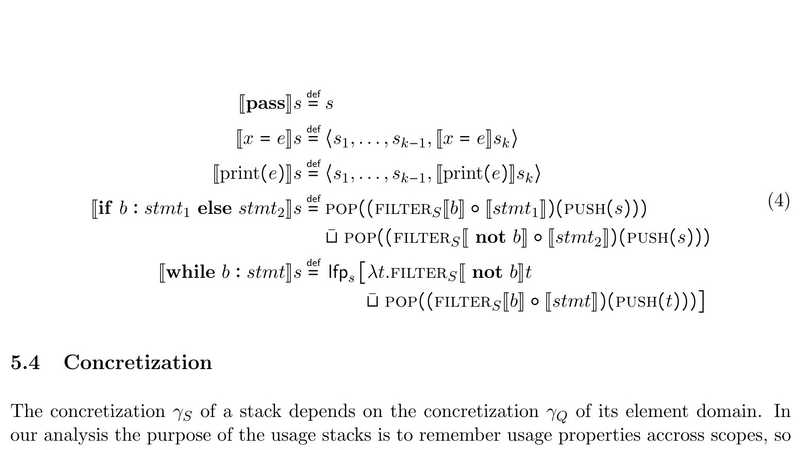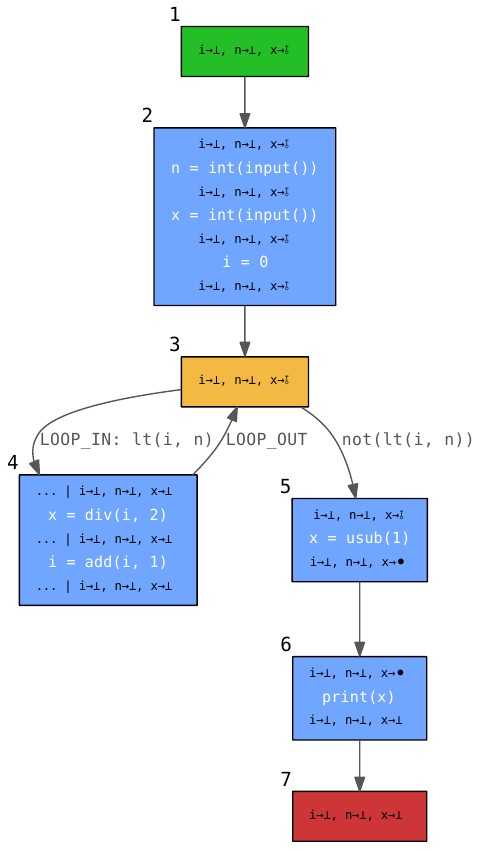
3. September 2020
My Master Thesis
Non-technical introduction
I was always excited by the type systems behind common languages, their strengths and weaknesses. That is why I got also interested in what properties of a program are possible to proof without actually executing it. In the computer science field of static analysis a helper program is designed to analyse certain properties of your main program. It can be written in the same or in a different language as the program to analyse. One has to use powerful formal methods to show that the analysis algorithms implemented in the helper program are sound within the execution model of the analysed program's language.
I built fundamental parts of a generic Static Analyser for Python that analyses program to detect unused variables. The analysis results or more precise compared to usual analysis present in many development environments (IDEs).
Download full Master Thesis
Checkout Repository with Code of Static Analyser
Example
This program written in the Python language has a bug in line 7.
n = int(input())
x = int(input())
i = 0
# RESULT: i→⊥, n→⊥, x→⫰̸while i < n :
x = i / 2 # Bug : should be x = x / 2 i = i + 1
else :
x = −1
print(x)The result of the analysis written in line 5 x→⫰̸ finds that variable x is no used further down in the program. This in turn means that the input value read into x is never used, which is probably a mistake.
This control flow graph generated by my analyser shows the abstraction of the program and the intermediate results of the backwards analysis leading to the conclusion in line 5:

Abstract
We introduce a new property of program inputs that denotes if the input is used and develop a fully-automatic, static analysis within the framework of Abstract Interpretation to approximate this property for both single inputs and input lists of unknown length. The developed analysis extends the well-studied truly-live variable analysis to the stronger property of usage: It detects for input items, or more generally for any program variable, if they have any effect on the output of the program. In Abstract Interpretation, an interpreter iterates over the code of a program without executing it on concrete inputs, and imitates parts of its behaviour with objects of an abstract universe, called abstract domain. Our analysis roots in an abstract usage domain, which holds information about which variables are used and how they can affect the usage property of other variables along the possible execution paths of the program. Combined with a stack-like structure, it can track the flow of usage through nested constructs like conditionals and loops. We can differentiate direct usage in the program output from implicit usage in conditions and transitive usage via assignments. We then extend the usage domain to be able to track the usage property not only for variables, but also for list items. This means we can find out if the individual values of a list of inputs are used, even if the length of the list is statically unknown. We achieve this by integrating the usage domain into an abstract domain to analyze list contents. This domain is based on the idea of splitting the list into segments with dynamic bounds, each segment holding an abstraction of the values the segment is covering. A prototype implementation of all presented domains and analysis was developed alongside this thesis. It demonstrates the potential usage scenarios in real-world programs typically written in data science applications.
Download full Master Thesis
Checkout Repository with Code of Static Analyser
